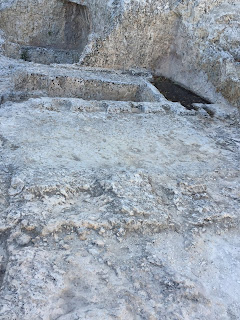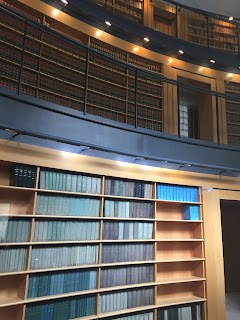ISRAEL AND THE PALESTINIANS PART II
Our good friends Max and Suzanne Singer found us a wonderful apartment in the Baka area of Jerusalem where we stayed our first week in Israel. The apartment was on the bottom of their street and easy walking distance to restaurants, markets and some tourist sites. We have known Max and Suzanne since the 1970’s when we both lived in the Bethesda-Chevy Chase suburbs of Washington and also had common ties in the Adirondacks. Some of our children went to school together. We have kept closely connected over the years even after they made aliyah (immigrated to Israel, from the Hebrew word "to ascend"), now live in Jerusalem joining their sons and their families who were already Israelis.
Max, an optimistic futurist, is a founder and past president of the Hudson Institute, a major Washington based think tank, providing a home to scholars around the country but especially in Washington, DC and Palo Alto, CA. He is now also a senior fellow of the Begin-Sadat Center for Strategic Studies at Bar Ilan University located in Beersheva, Israel. Suzanne, a scholar in her own right, has been the editor of Biblical Archeological Review, Moment Magazine and Bible Review. Their collective knowledge of Israel past and present is most impressive.
 |
| Owners' Garden |
 |
| On our walk to Emek Refriam Street, Commercial Area in Baka Neighborhood |
 |
| Garden Path |
 |
| Singer Apartment Building |
On Friday, December 7, 2018 coincident with the 6thnight of Chanukah, the Wall Street Journal published an op-ed by Max that reflects much of what we saw and heard in our travels in Israel. While we have included the full text below, we’ve also including link if you wish to pass it on. https://www.wsj.com/articles/refute-palestinian-lies-to-promote-mideast-peace-1544139570
Refute Palestinian Lies to Promote Mideast Peace
Wall Street Journal print edition, December 7, 2018
There’s no ‘occupied’ territory, and the Jews have been in Israel for thousands of years.
‘Our demand for fairness for Israel is actually a demand for peace,” declared Nikki Haley in July. It’s important for the U.S. ambassador to the United Nations to stress fairness, and above all truth, in the Israeli-Palestinian conflict, because Palestinian rejection of peace frequently hides behind falsehoods. Ending the acceptance of these falsehoods is critical to putting Middle East diplomacy on a path toward peace.
The U.S. has already acted to gain recognition of three key truths that had long been diplomatically ignored: Jerusalem is the capital of Israel; very few of the Palestinians that the U.N. Relief and Works Agency supports are actually refugees; and the U.N. has been unacceptably biased against Israel.
Now the U.S. can tip the political balance toward peace and stability by insisting on two other truths. First, despite widespread use of the term in diplomatic documents and debate, there is no such thing as “occupied Palestinian territory” because there has never been a Palestinian territory to occupy. As some Palestinians point out, they have never had a state of their own. This is far more than a game of semantics. If the land was Palestinian, then Israel could have stolen it. If the land isn’t Palestinian, then Israel couldn’t have stolen it. It’s critical that the U.S. actively combat the falsehood that Israel exists on stolen Palestinian land.
The second falsehood is married to the first. The Palestinians not only claim that all the land is theirs, they also deny any Jewish connection to it. During the failed Camp David talks in 2000, Palestinian Authority President Yasser Arafat stunned President Clinton by asserting the Jews had no connection to the Temple Mount in Jerusalem, the place where the first and second Jewish temples stood.
Mr. Clinton may have been surprised, but the Palestinian denial of any historic Jewish connection to the land is nothing new, and it continues. Since the Palestinians know that hardly anyone outside the Arab world who would agree with them, they rarely say it in English.
But there is no such restraint on official Arabic-language Palestinian television. On March 15, 2017, a presenter said there is “no evidence” that Jews prayed at the Western Wall—where Jews have faced to pray for 2,000 years—before 1917. On Nov. 15, 2017, a Palestine Liberation Organization official went on the air and said, “It is a Zionist invention that this is the land of the Patriarchs. . . . The Jews were expelled from Europe to get rid of them so that the West would have a permanent base in the Middle East.” The Palestinian narrative, drummed in through the schools and media, is that Israel is a “crusader state” that will eventually be eliminated. Everyone has a right to his opinion, as Sen. Daniel Moynihan observed, but not his own facts. Ancient Israel is a historical fact, founded by King David in 10th century B.C., interrupted by the Babylonian exile in the sixth century B.C. and ending with the Roman sacking of the Second Temple in A.D. 70. Even during the exile there was a continuous small Jewish presence in the land of Israel. In Jerusalem Jews became a plurality of the population by the middle of the 19th century.
Palestinian denial of this history has consequences. If the Jews had no connection to the land, recognizing Israel would be a capitulation and a humiliation. But because the Jews, like the Palestinians, have legitimate claims, peace with Israel can be based on an honorable compromise.
The U.S. should demand that Palestinian leaders recognize the Jewish connection to the land, no less than Israelis recognize the Palestinian presence and demand for statehood. The denial of Jewish history leads to the denial of Israel’s right to exist. So long as this continues, it is the Palestinians, not the Israelis, who are refusing to accept a two-state solution—and the U.S. should say so.
The truth is important, but it may not be enough. The U.S. should launch a diplomatic campaign to persuade other nations and international bodies to set the record straight. It’s important to explain that parroting Palestinian falsehoods harms the cause of peace.
Within the community of nations, the U.S. truth campaign might seem quixotic, but U.S. persistence could embolden suppressed moderates in the Arab world. By speaking the truth, the U.S. could help give these brave people a voice.
Mr. Singer is a founder and former president of the Hudson Institute, a senior fellow of the Begin-Sadat Center for Strategic Studies of Bar Ilan University, and author of “History of the Future.”


























































